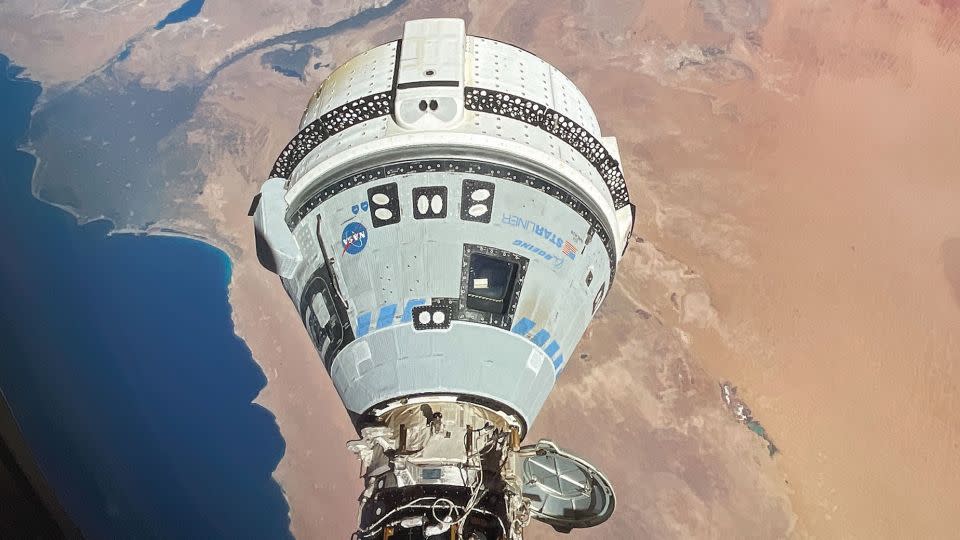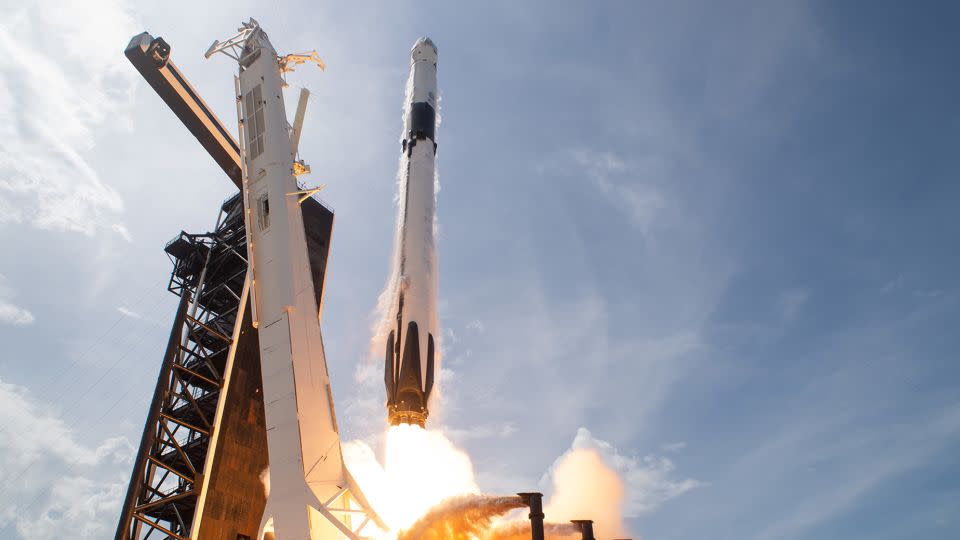Sign up for CNN’s Wonder Theory science newsletter. Explore the universe with news on fascinating discoveries, scientific advancements and more.
Boeing’s Starliner spacecraft was set to mark its crowning achievement this month: Ferrying two NASA astronauts on a round trip to the International Space Station, proving the long-delayed and over-budget capsule is up for the task.
Starliner is halfway to that goal.
But the two veteran astronauts piloting this test flight are now in a tentative position — extending their stay aboard the space station for a second time while engineers on the ground scramble to learn more about issues that plagued the first leg of their journey.
Spaceflight veterans Suni Williams and Butch Wilmore arrived at the space station aboard the Starliner on June 6. NASA initially projected their stay would last about a week.
But troubles the vehicle experienced en route, including helium leaks and thrusters that abruptly stopped working, have raised questions about how the back half of the mission will play out.
Williams and Wilmore will now return no earlier than June 26, NASA announced Tuesday, stretching their mission to at least 20 days as engineers race to gain a better understanding of the spacecraft’s problems while it’s safely attached to the space station.
Officials have said there is no reason to believe Starliner won’t be able to bring the astronauts back home, though “we really want to work through the remainder of the data,” said Steve Stich, NASA’s Commercial Crew Program manager, at a Tuesday news conference.
Meanwhile, Boeing has sought to frame the mission as a success and learning opportunity, albeit one that has left the Starliner team grappling with the “unplanned” side of the mission, as Mark Nappi, Boeing’s vice president and program manager of the Starliner program, put it Tuesday.
It’s not uncommon for astronauts to unexpectedly extend their stay aboard the space station — for days, weeks or even months. (NASA has also said the Starliner can spend up to 45 days at the orbiting laboratory if needed, according to Stich.)
But the situation makes for a moment of uncertainty and embarrassment that joins a long list of similar blunders by the Boeing Starliner program, which is already years behind schedule. It also adds to a chorus of unfavorable news that has followed Boeing as a company for some time.
A nail-biting finale
Boeing and NASA engineers said they are opting to leave Starliner — and with it, Williams and Wilmore — aboard the station longer than expected primarily to carry out additional analysis. The helium leaks and thruster issues occurred on a part of the vehicle that is not intended to survive the trip home from space, so mission teams are delaying the spacecraft’s return as part of a last-ditch effort to learn everything they can about what went wrong.
Danger looms any time a spacecraft returns home from orbit. It is perhaps the most perilous stretch of any mission to space.

The trip will require the Starliner to hit Earth’s thick atmosphere while traveling more than 22 times the speed of sound. The process will bake the spacecraft’s exterior at roughly 3,000 degrees Fahrenheit.
Then, a set of parachutes — which Boeing redesigned and tested as recently as January — must safely slow the capsule down before it reaches terra firma. (Starliner will be the first US-made capsule to parachute to a landing on the ground rather than splash down in the ocean. Boeing hopes that approach will make it easier to recover and refurbish the Starliner after flight.)
A series of setbacks
Starliner’s journey to this historic crewed test mission began in 2014 when NASA tapped both Boeing and SpaceX to develop a spacecraft capable of carrying astronauts to the International Space Station.
At the time, Boeing was seen as the stalwart aerospace giant that would likely get the job done first while SpaceX was the unpredictable newcomer.
Over the past decade, however, tides have shifted.
SpaceX’s Crew Dragon spacecraft safely completed its first crewed mission — which appeared to go off without a hitch — in 2020. And the vehicle has been regularly flying astronauts and paying customers since.

The two astronauts that piloted Crew Dragon’s inaugural flight — Bob Behnken and Doug Hurley — also stayed aboard the space station longer than expected, notching more than 60 days rather than the brief stint expected on such test flights.
But Hurley and Behnken’s stay was extended so that the astronauts could lend a hand with daily activities aboard the space station, which at the time was understaffed. The extension did not directly relate to specific software or hardware problems with SpaceX’s Crew Dragon.
Spacecraft issues, on the other hand, have marred Boeing’s Starliner program practically every step of the way. The vehicle has faced years of delays, setbacks and added expenses that have cost the company more than $1 billion, according to public financial records.
The first Starliner test mission, flown without crew in late 2019, was riddled with missteps. The vehicle misfired in orbit, a symptom of software problems that included a coding error that set an internal clock off by 11 hours.
A second uncrewed flight test in 2022 uncovered additional software issues and trouble with some of the vehicle’s thrusters.
Stich, the NASA program manager, indicated during a June 6 news conference that it’s possible engineers may not have completely resolved those issues from 2022.
“We thought we had fixed that problem,” Stich said, adding, “I think we’re missing something fundamental that’s going on inside the thruster.”
Michael Lembeck, an aerospace engineering associate professor of practice at the University of Illinois Urbana-Champaign who was a consultant for Boeing’s spaceflight division from 2009 to 2014, told CNN that it would be difficult to determine whether additional ground tests may have caught the thruster issues at hand.
But Lembeck emphasized that evaluating the success of this test mission is not as simple as comparing it directly with the inaugural crewed test flight of SpaceX’s Crew Dragon.
For example, he said, SpaceX’s Dragon cargo capsule — a director predecessor of Crew Dragon — completed more than a decade of uncrewed cargo missions to the space station before Crew Dragon took flight.
“SpaceX did have a head start with the cargo program,” Lembeck said. “I think they do have an advantage that Boeing did not have. Boeing’s kind of having to build a crew vehicle all up from scratch.”
Should this Starliner test mission encounter additional setbacks, however, it could put Boeing in a situation where it must rely on its rival to get Williams and Wilmore home.
“The embarrassing backup is that a Crew Dragon would have to go and retrieve the astronauts,” Lembeck said. The spacecraft “could be sent up with two crew members and sent back with four — and that would probably be the way home.”
Boeing’s broader problems
Boeing executives have repeatedly sought to make clear that the Starliner program operates independently from the company’s other units — including the commercial aircraft division that has been at the center of scandals for years.
“We have humans flying on this vehicle. We always take that so seriously,” Nappi said during a news briefing in April before Starliner took flight.
Nappi at the time also declared that the Starliner team was operating at “peak performance” and “really looking forward to executing” a safe mission.
When asked about that assertion on Tuesday, Stich, the NASA executive, said that officials at Boeing and NASA had always expected to find additional issues that needed to be hashed out during this test flight.
Williams had alluded to that expectation during a pre-flight news conference, saying, “We always find stuff, and we are going to continually find stuff.
“Everything’s not going to be absolutely perfect as we fly the spacecraft. …We feel very safe and comfortable with how this spacecraft flies, and we have backup procedures in case we need those,” Williams said.
Stich, however, acknowledged on Tuesday that Boeing and NASA might have been able to prevent some of the hangups the Starliner has encountered: “Perhaps we could have done different testing on the ground to characterize some of (the thruster issues) ahead of time,” he said.
For more CNN news and newsletters create an account at CNN.com